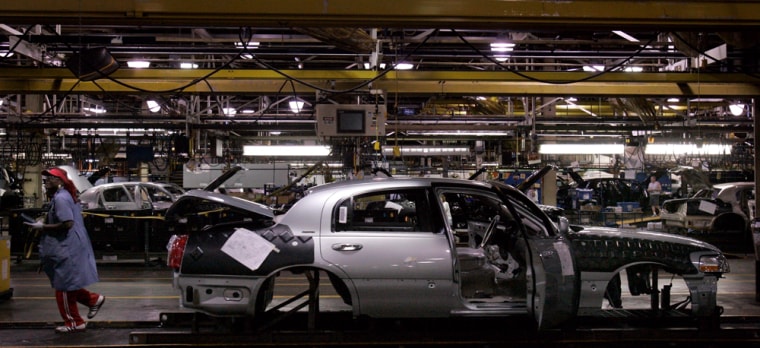Toyota Motor Corp. led all North American automakers in manufacturing productivity last year, but Detroit’s three automakers continued to close the gap with their Japanese rivals, according to a study watched closely by the industry.
The annual report, which was released Thursday and prepared by Troy-based Harbour Consulting, compares labor productivity at six companies that have North American plants.
It took Toyota 29.93 labor hours to build components and assemble each vehicle.
Nissan Motor Co., 2005’s most productive company, finished second at 29.97 hours, but Harbour Consulting had to estimate that figure because Nissan would not provide 2006 data.
Honda Motor Co. finished third at 31.63 hours, followed by General Motors Corp. at 32.36 and DaimlerChrysler AG at 32.9, Harbour reported. Ford Motor Co. finished last at 35.1 hours, but that was nearly a 2 percent improvement over 2005’s 35.8 hours.
Harbour Consulting President Ron Harbour said the difference between the most and least productive companies last year was 5.17 hours, more than two hours better than the 7.33-hour gap in 2005. Yet the gap still is equal to about $300 per vehicle in favor of Toyota, the study said.
The productivity gain came because Toyota’s performance declined while the Detroit Three continued to improve. Ford and GM became more productive by shedding thousands of workers through buyouts and early retirement offers, and all three continued to work with unions to negotiate away work rules that place them at a disadvantage to the Japanese companies, Harbour said. The improvements came even though sales and production declined for all three Detroit automakers, he said.
“I think it’s a major point that Ford, Chrysler and GM all made improvements despite the fact that they all had some significant drops in volume,” he said. “When you’re losing production volume that fast, it’s pretty hard to make productivity improvements.”
Toyota’s labor hour total was 1.8 percent longer than 2005, mainly due to a large number of new models launched at its plants, including the new Camry and Tundra pickup trucks, Harbour said.
Honda, DaimlerChrysler and GM all showed better than 2 percent improvements, according to the report.
Ford, GM and Chrysler could narrow the gap even further in 2007, because they didn’t realize the full impact of productivity improvements in 2006, Harbour said. One of them could even overtake Toyota if production volumes don’t drop too much, he said.
“We should see a big improvement in the Big Three’s numbers overall in 2007,” Harbour said.
The Detroit Three have been steadily catching up to Japanese automakers. The difference between the most productive and the least productive automakers was 9.1 hours in 2004 and 16.6 hours in 1998.
GM had four of the top 10 most productive vehicle assembly plants, including the most productive plant in the study, Oshawa No. 2 in Oshawa, Ontario.
Joe Hinrichs, Ford’s vice president of North American manufacturing, said although his company is behind competitors, it has seen five straight years of productivity improvements.
“Our rate of improvement was better than some,” Hinrichs said.
He added that Ford has worked with union leaders on forging agreements to make plants more efficient. That includes allowing workers to do multiple jobs and contracting out traditional union jobs to save money.
Harbour said such agreements are a necessity as the Detroit Three try to return to profitability.
According to the study, Ford lost $5,234 per vehicle before taxes last year, followed by GM with a $1,436 loss and DaimlerChrysler, which lost $1,072 per vehicle.
In contrast, Toyota made $1,266 per vehicle, while Honda made $1,368 and Nissan made $1,575.
While Harbour gives the United Auto Workers and Canadian Auto Workers credit for helping the Detroit Three reduce costs, he said more must be done in the upcoming U.S. national contract talks.
“They have really come to the party here and made some really big improvements,” he said. “But there’s still some things out there.”
The Detroit Three have to erase productivity differences at any cost because their viability depends on it, Harbour said. Generally, wages and benefits cost the Detroit Three about $30 per hour more than Asian competitors with North American plants.
“It’s to the point now where some of those clauses in the labor agreements are now standing out. They’re really being highlighted,” Harbour said.
Nissan, which by Harbour’s estimates increased its hours of production by 5.3 percent in 2006, said it stopped providing data this year because collecting the information solely for the report was becoming costly and time-consuming, said spokeswoman Vicki Smith.
The Harbour Report, first published in 1989, measures productivity at assembly, stamping and engine and transmission plants. It calculates the number of hours worked by salaried and hourly employees at a plant and divides that by the number of units produced.
